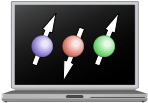by Travis Beals.
| Main | Installation | Tutorial | Code Overview |

qsims was developed as a tool for studying quantum computing in addressable optical lattices. It is a general-purpose quantum simulation software package, capable of simulating the dynamics of systems with a wide range of Hamiltonians. qsims is by no means limited to optical lattices, and could be adapted for use in many other physical systems, or for use as a teaching tool.

qsims represents the spatial wavefunction of a particle as a discretized wavefunction on a grid. Internal states of the particle can be represented using multiple grids. Potentials and couplings between the internal states can be specified, and potentials can be position- and state-dependent.
qsims calculates the Schrodinger propagator exp[-i H t] by using a Chebychev polynomial expansion. This has the advantage that the expansion has an exponential cut-off after a certain point, allowing for extremely high precision with a reasonably small number of terms. The kinetic portion of the wavefunction is calculated by Fourier transforming the spatial wavefunction into momentum space, where p2 is easily calculated. See the works of R. Kosloff for more details.
qsims is Free Software (licensed under the GNU General Public License 2), so it costs you nothing to download and use, and you are free to modify and redistribute the code under the same license. qsims is still under development, so you may find some rough edges and bugs. If you use qsims in your research, please acknowledge the author of qsims (Travis Beals) in your publications. Contact him at trbeals at users d0t sourceforge d0t net for more information. If you make any improvements to qsims, please contribute them back to the qsims project (you are requested but are of course not obligated to do this).
| qsims is hosted by |
Last updated 6 April 2005 by Travis Beals. |